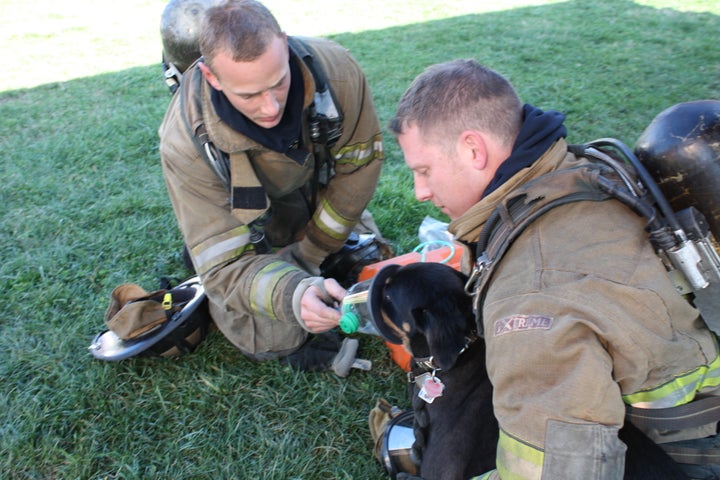
Pets are no strangers to the woes of Mother Nature. The Texas wildfires sweeping across the state this week are no exception.
Though there are no official statistics on the number of animals killed during fires, estimates suggest some 40,000 to 150,000 pets die each year in fires; most succumbing to smoke inhalation, says the Rhode Island Veterinary Medical Association.
One item popping up on fire trucks to safeguard animals from smoke inhalation is pet oxygen masks, says Ines de Pablo, CEO of Wag'N Enterprises, a company that specializes in pet safety.
Specifically designed to fit over the muzzle of an animal, these masks allow animals to receive pure oxygen after exposure to a fire and smoke inhalation. Like humans, smoke toxins fill up the lungs, putting pets at risk of asphyxiation.
"A pet oxygen kit generally has a small oxygen tank and three sizes of masks that can accommodate animals from as small as ferrets to as large as horses," de Pablo told The Huffington Post.
Wag'N Enterprises, as well as other animal pet companies and animal welfare agencies supply fire houses with this equipment, which either comes from the company or is funded by donations from the community. The fire houses must train staff in fitting an oxygen mask on a pet, but no other costs are involved.
Priced at $70 for the kit, pet suppliers and animal advocacy groups are adamant about supplying fire houses. Wag'N Enterprise's goal is to fit every fire station in North America with a pet oxygen mask kit.
CNBC notes that "this is a business, and the point is to make money. However, the company says growing margins is not its primary focus right now."
Wag’N has so far helped emergency responders in 44 states and the District of Columbia get pet oxygen kits. In the U.S. and Canada, Wag’N has put 2,185 pet oxygen kits in 950 different departments since 2008.
Pet oxygen masks are nothing new. They've been around to assist veterinarians for years, but fitting First Responders with the equipment is starting to become a must-have for local fire stations.
One of the major roadblocks to broader usage is lack of awareness. When de Pablo approaches fire houses about donating pet oxygen masks to stations, hostility and confusion are common reactions. "We are not asking them to choose animals over humans," she says. "But if they happen to be on the 15th floor and they happen to see a human and a cat, then take the pet with them."
Though there's no accurate data on how many animal lives have been saved, there are a number of heart-warming success stories.
In Huntington, West Virginia, a cat named Duchess was saved from a burning kitchen, reports the Herald-Dispatch. When firefighter Tommy Mitchell walked her out of the house, she collapsed in his arms, the news source writes. Luckily, fellow firefighter Mike Smith used the oxygen mask to successfully resuscitate Duchess.
Firefighter Captain Paul Spain from Kennett Fire Department in Missouri wrote to de Pablo's blog about how he saved a puppy from a fire residence this past March. The dog suffered from mild smoke inhalation after hiding under a bed in a smoke filled room. He wrote, "Placed patient on oxygen for approximately 15 minutes with noted improvement and recovery."
Since Hurricane Katrina (where 600,000 animals were abandoned or killed) including pets in emergency care is finally getting attention. It provoked the U.S. House of Representatives to pass the bipartisan Pet Evacuation and Transportation Standards Act which requires companion and "service" animals to be accommodated by states seeking help from FEMA. During Hurricane Irene, pets were allowed in some shelters.
To learn more about how you can you get kits for your local First Responders, visit the Wag'N Enterprises website.